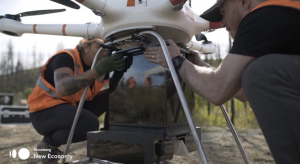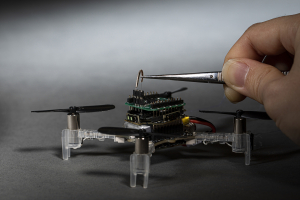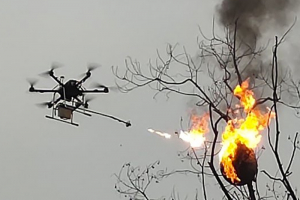
IF IT SOUNDS LIKE BEES, AND SWARMS LIKE BEES,
IT MUST BE BEES. RIGHT?

Image Courtesy: Bloomberg
The company in question, DroneSeed, didn’t make the PropellerHeads cutbecause it can plant more than the others, or their drones fly longer. No, the reason is much more boring than that.
They recently received approval from the FAA to fly large drone swarms beyond Visual Line of Sight (BVLOS) in California, Colorado, Montana, Nevada, Arizona, and New Mexico. They were already operating in Oregon, Washington, and Idaho.
See, pretty boring. But I guess if you’re reading a drone newsletter, it’s not boring to you. Lame-o.
The advance is pretty huge. Add swarm technology for reforestation and replanting of land efforts post wildfires to the list of BVLOS applications. Instead of sending one drone up to fly a grid pattern, just send a line of drones across a field all at once. It’s more efficient, and looks cooler too. Also, DroneSeed charges by the acre vs. by flight hours. They aren’t messing around.
PART INSECT, PART MACHINE, ALL AWESOME.

Aptly named the Smellicopter, this drone’s design isn’t influenced by nature like others we’ve discussed before. It just takes nature to function properly. They use real moth antennae and put them on the drone. Yes. On the drone. From a moth, to a drone. Kyle in our office said this sounds like animal abuse, but we’re certain they’re harvesting their antennae responsibly.
The drone’s purpose is not just to appease the sick curiosity of scientists at the University of Washington, it’s to send a small drone in where humans cannot go and send back information on gas, explosive materials, or even the smells of survivors. Because they’re utilizing a moth’s antenna, they don’t need to put heavy less effective sensors on board. And as you all know, less weight = more flight. They only need to attach a wire to the antenna and they can then measure the response they receive back. We’re not sure if this is the first bio-hybrid drone in the world, but it’s the first we’ve heard of one!
THE TRUE PURPOSE OF DRONES. KILLING INSECTS

There’s the easy, slow way by using pesticides, but why not run before you walk? A company in China, Blue Sky Rescue, raised the money from the community to buy a drone so they could attach a gas tank and a nozzle to literally incinerate bugs throughout the whole county. The crowd funded buying a drone to set bugs on FIRE.
If your heart doesn’t grow 2 sizes after hearing that, there’s no help for you this holiday season… This isn’t just one or two nests in a small village, this is an outbreak of hornets that have killed 100’s of people. So the outrageous response does seem a fitting, but as companies gear up to try and figure out a way to use drones to stop forest fires, others seem to be coming up with ways to start them. And there’s also a level of environmental risk. Wasps suck, but at least they kill other bugs that eat crops. Wasps help bees pollinate too! But like good ole’ Uncle Skyfire once said, “I don’t trust nothin’ that ain’t got shoulders.” And we live by that.
A FEW MORE FOR YOUR BRAIN
UPCOMING EVENTS
- Feb 15th – Integration of UAS into Law Enforcement Field Operations
- Feb 15th – Online Part 107 | One-day Class
Alright, folks — that’s it! Hope you have a great week!
P.S. You digging Propeller Heads? Yeah? Us, too! Why don’t you forward it over to a buddy or encourage them to sign up here. We have a blast putting it together each time and the more the merrier!